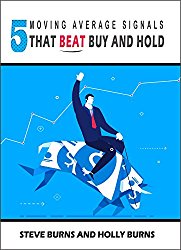
Most the investing establishment considers buy and hold investing the Holy Grail that always works out in the long term. For long term buy and hold investing your entry time frame matters, whether you got in at good prices and if you have time after bear markets to get back to even. NASDAQ buy and holders waited a long time from March of 2000 and buy and holders from 2007 also had to wait many years to get back to where they were. The most simple long term moving average systems can beat buy and hold by getting and keeping you in during bull markets and getting you out before big drawdowns. You are capping your downside risk and keeping your upside potential profits open by simply having an entry and exit strategy based on price action not opinions or predictions.
A systematic way to use quantified signals to get in to stock holdings at the beginning of bull markets and then get out before corrections, bear markets, and crashes is to use long term moving averages as trend trading filters. The 200 day simple moving average alone as trend following system beats buy and hold investing in both returns and drawdowns over most long term backtesting timeframes. If you want more room to not be shaken out during volatility or price noise inside a bull market the 250 day moving average can work even better at times.
From January 2000 to September 2016 $QQQ buy and hold returned 36.5% with a 83% drawdown.
For $QQQ using the 200 day SMA as an end of day sell/buy indicator from January 2000 to September 2016: 200 day SMA returns were 52.1% with a 58.3% drawdown. We increased returns by 16% and cut the drawdown by about one third versus buy and hold.
For $QQQ using the 250 day SMA as an end of day sell/buy indicator from January 2000 to September 2016: 250 day SMA returns were 104.6% with a 40.9% drawdown. We almost tripled returns and also cut the drawdown in half versus buy and hold.
From January 2000 to October 2015 $SPY buy and hold returned 91% with a 55.2% drawdown.
For $SPY using the 200 day SMA as an end of day sell/buy indicator from January 2000 to October 2015: 200 day SMA returns were 96.1% with a 27.3% drawdown. We cut the drawdown in half.
For $SPY using the 250 day SMA as an end of day sell/buy indicator from January 2000 to October 2015: 250 day SMA returns were 120.5% with a 23.1% drawdown. We cut the drawdown in half and increased the return.
These are the most simple examples of mechanical long term moving average trend trading systems. For five moving average signals that have historically beat buy and hold investing when used with the $SPY ETF check out my newest book: 5 Moving Average Signals That Beat Buy and Hold.